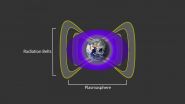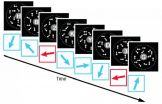(Press-News.org) Two donuts of seething radiation that surround Earth, called the Van Allen radiation belts, have been found to contain a nearly impenetrable barrier that prevents the fastest, most energetic electrons from reaching Earth.
The Van Allen belts are a collection of charged particles, gathered in place by Earth's magnetic field. They can wax and wane in response to incoming energy from the sun, sometimes swelling up enough to expose satellites in low-Earth orbit to damaging radiation. The discovery of the drain that acts as a barrier within the belts was made using NASA's Van Allen Probes, launched in August 2012 to study the region. A paper on these results appeared in the Nov. 27, 2014, issue of Nature magazine.
"This barrier for the ultra-fast electrons is a remarkable feature of the belts," said Dan Baker, a space scientist at the University of Colorado in Boulder and first author of the paper. "We're able to study it for the first time, because we never had such accurate measurements of these high-energy electrons before."
Understanding what gives the radiation belts their shape and what can affect the way they swell or shrink helps scientists predict the onset of those changes. Such predictions can help scientists protect satellites in the area from the radiation.
The Van Allen belts were the first discovery of the space age, measured with the launch of a US satellite, Explorer 1, in 1958. In the decades since, scientists have learned that the size of the two belts can change - or merge, or even separate into three belts occasionally. But generally the inner belt stretches from 400 to 6,000 miles above Earth's surface and the outer belt stretches from 8,400 to 36,000 miles above Earth's surface.
A slot of fairly empty space typically separates the belts. But, what keeps them separate? Why is there a region in between the belts with no electrons?
Enter the newly discovered barrier. The Van Allen Probes data show that the inner edge of the outer belt is, in fact, highly pronounced. For the fastest, highest-energy electrons, this edge is a sharp boundary that, under normal circumstances, the electrons simply cannot penetrate.
"When you look at really energetic electrons, they can only come to within a certain distance from Earth," said Shri Kanekal, the deputy mission scientist for the Van Allen Probes at NASA's Goddard Space Flight Center in Greenbelt, Maryland and a co-author on the Nature paper. "This is completely new. We certainly didn't expect that."
The team looked at possible causes. They determined that human-generated transmissions were not the cause of the barrier. They also looked at physical causes. Could the very shape of the magnetic field surrounding Earth cause the boundary? Scientists studied but eliminated that possibility. What about the presence of other space particles? This appears to be a more likely cause.
The radiation belts are not the only particle structures surrounding Earth. A giant cloud of relatively cool, charged particles called the plasmasphere fills the outermost region of Earth's atmosphere, beginning at about 600 miles up and extending partially into the outer Van Allen belt. The particles at the outer boundary of the plasmasphere cause particles in the outer radiation belt to scatter, removing them from the belt.
This scattering effect is fairly weak and might not be enough to keep the electrons at the boundary in place, except for a quirk of geometry: The radiation belt electrons move incredibly quickly, but not toward Earth. Instead, they move in giant loops around Earth. The Van Allen Probes data show that in the direction toward Earth, the most energetic electrons have very little motion at all - just a gentle, slow drift that occurs over the course of months. This is a movement so slow and weak that it can be rebuffed by the scattering caused by the plasmasphere.
This also helps explain why - under extreme conditions, when an especially strong solar wind or a giant solar eruption such as a coronal mass ejection sends clouds of material into near-Earth space - the electrons from the outer belt can be pushed into the usually-empty slot region between the belts.
"The scattering due to the plasmapause is strong enough to create a wall at the inner edge of the outer Van Allen Belt," said Baker. "But a strong solar wind event causes the plasmasphere boundary to move inward."
A massive inflow of matter from the sun can erode the outer plasmasphere, moving its boundaries inward and allowing electrons from the radiation belts the room to move further inward too.
INFORMATION:
The Johns Hopkins Applied Physics Laboratory in Laurel, Maryland, built and operates the Van Allen Probes for NASA's Science Mission Directorate. The mission is the second in NASA's Living With a Star program, managed by Goddard.
For more information about the Van Allen Probe, visit:
http://www.nasa.gov/vanallenprobes
PROVIDENCE, R.I. [Brown University] -- A new study led by Brown University reports that older learners retained the mental flexibility needed to learn a visual perception task but were not as good as younger people at filtering out irrelevant information.
The findings undermine the conventional wisdom that the brains of older people lack flexibility, or "plasticity," but highlight a different reason why learning may become more difficult as people age: They learn more than they need to. Researchers call this the "plasticity and stability dilemma." The new study suggests ...
VIDEO:
When people hear another person talking to them, they respond not only to what is being said -- those consonants and vowels strung together into words and sentences --but also...
Click here for more information.
When people hear another person talking to them, they respond not only to what is being said--those consonants and vowels strung together into words and sentences--but also to other features of that speech--the emotional tone and the speaker's gender, for instance. ...
Older people can actually take in and learn from visual information more readily than younger people do, according to new evidence reported in the Cell Press journal Current Biology on November 26. This surprising discovery is explained by an apparent decline with age in the ability to filter out irrelevant information.
"It is quite counterintuitive that there is a case in which older individuals learn more than younger individuals," says Takeo Watanabe of Brown University.
Older individuals take in more at the same time as the stability of their visual perceptual ...
Enzymes inside cells that normally repair damaged DNA sometimes wreck it instead, researchers at the Stanford University School of Medicine have found. The insight could lead to a better understanding of the causes of some types of cancer and neurodegenerative disease.
In a paper to be published online Nov. 27 in Molecular Cell, the researchers explain how the recently discovered mechanism of DNA damage occurs when genetic transcripts, composed of RNA, stick to the DNA instead of detaching from it.
Certain enzymes, called endonucleases, are attracted to DNA/RNA hybrids ...
Researchers at the Center for iPS Cell Research and Application (CiRA), Kyoto University, show that induced pluripotent stem (iPS) cells can be used to correct genetic mutations that cause Duchenne muscular dystrophy (DMD). The research, published in Stem Cell Reports, demonstrates how engineered nucleases, such as TALEN and CRISPR, can be used to edit the genome of iPS cells generated from the skin cells of a DMD patient. The cells were then differentiated into skeletal muscles, in which the mutation responsible for DMD had disappeared.
DMD is a severe muscular degenerative ...
Mutations in the KRAS gene have long been known to cause cancer, and about one third of solid tumors have KRAS mutations or mutations in the KRAS pathway. KRAS promotes cancer formation not only by driving cell growth and division, but also by turning off protective tumor suppressor genes, which normally limit uncontrolled cell growth and cause damaged cells to self-destruct.
A new University of Iowa study provided a deeper understanding of how KRAS turns off tumor suppressor genes and identifies a key enzyme in the process. The findings, published online Nov. 26 in the ...
SALT LAKE CITY--Researchers from Huntsman Cancer Institute (HCI) at the University of Utah (U of U) discovered the unusual role of lactate in the metabolism of alveolar soft part sarcoma (ASPS), a rare, aggressive cancer that primarily affects adolescents and young adults. The study also confirmed that a fusion gene is the cancer-causing agent in this disease. The research results were published online in the journal Cancer Cell Nov. 26, 2014.
ASPS tumor cells contain a chromosomal translocation--strands of DNA from two chromosomes trade places. The two strands fuse ...
MINNEAPOLIS / ST. PAUL (11/26/2014)--During a thunderstorm, we all know that it is common to hear thunder after we see the lightning. That's because sound travels much slower (768 miles per hour) than light (670,000,000 miles per hour).
Now, University of Minnesota engineering researchers have developed a chip on which both sound wave and light wave are generated and confined together so that the sound can very efficiently control the light. The novel device platform could improve wireless communications systems using optical fibers and ultimately be used for computation ...
In recent years it has been established that copper plays an essential role in the health of the human brain. Improper copper oxidation has been linked to several neurological disorders including Alzheimer's, Parkinson's, Menkes' and Wilson's. Copper has also been identified as a critical ingredient in the enzymes that activate the brain's neurotransmitters in response to stimuli. Now a new study by researchers with the U.S. Department of Energy (DOE)'s Lawrence Berkeley National Laboratory (Berkeley Lab) has shown that proper copper levels are also essential to the health ...
Lincoln, Neb., Nov. 26, 2014 -- By solving a six-dimensional equation that had previously stymied researchers, University of Nebraska-Lincoln physicists have pinpointed the characteristics of a laser pulse that yields electron behavior they can predict and essentially control.
It's long been known that laser pulses of sufficient intensity can produce enough energy to eject electrons from their ultrafast orbits around an atom, causing ionization.
An international team led by the UNL researchers has demonstrated that the angles at which two electrons launch from a helium ...







